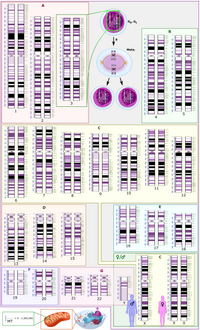
Photo from wikipedia
There is growing, but inconsistent evidence suggesting oestrogen may play a key role in lung cancer development, especially among never‐smoking women for whom lung cancer risk factors remain largely elusive.… Click to show full abstract
There is growing, but inconsistent evidence suggesting oestrogen may play a key role in lung cancer development, especially among never‐smoking women for whom lung cancer risk factors remain largely elusive. Using the China Kadoorie Biobank, a large‐scale prospective cohort with 302 510 women aged 30 to 79 years recruited from 10 regions in China during 2004 to 2008, we assessed the risk of lung cancer death among self‐reported never‐smoking women who were cancer‐free at baseline, in relation to age at menarche, age at menopause, time since menopause, prior use of oral contraceptives (OCP), number of livebirths, breastfeeding and age at first livebirth. Women were followed up to December 31, 2016 with linkage to mortality data. Hazard ratios (HR) and 95% confidence intervals (CI) were estimated using Cox regression, adjusting for key confounders including several socio‐demographic, environmental and lifestyle factors. Among 287 408 never‐smoking women, 814 died from lung cancer with a median follow‐up of 10.3 years. Women who had used OCP within 15 years prior to baseline had a significantly higher hazard of lung cancer death compared with never‐users: HR = 1.85 (95% CI: 1.14‐3.00) and risk increased by 6% with each additional year of use: HR = 1.06 (1.01‐1.10). Among parous women, the hazard of lung cancer death increased by 13% with each single livebirth: HR = 1.13 (1.05‐1.23); and among post‐menopausal women, the risk increased by 2% with each year since menopause: HR = 1.02 (1.01‐1.04). These results suggest that reproductive factors which were proxies for lower endogenous oestrogen level, for example, longer duration of OCP use, could play a role in lung cancer development.
Journal Title: International Journal of Cancer
Year Published: 2023
Link to full text (if available)
Share on Social Media: Sign Up to like & get
recommendations!